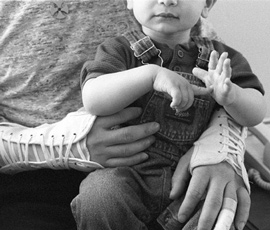
While working at a fish processing plant in Alaska, this worker got carpal tunnel syndrome.
Photo from Jim West.
Work-related Injuries and Deaths
The Occupational Safety and Health Administration (OSHA), is an agency established within the U.S. Department of Labor in 1970. OSHA develops guidelines and issues regulations for safety and health standards, and conducts inspections of workplaces for compliance with these standards. In instances of noncompliance, it issues citations and proposes penalties. In the 1980s and 1990s, OSHA took a more active role in protecting against health hazards in the workplace, seeking to limit the exposure of workers to hazardous substances such as lead, asbestos, pesticides, and toxic chemicals. From 1980 until 1997, 103,945 civilian workers died in the United States from occupational injuries, an average of 16 work-related deaths per day. The number of occupational deaths declined 28 percent from 7,343 in 1980 to 5,285 in 1997. The most hazardous industries to workers were the mining, agriculture/forestry/fishing, and construction industries. From 1980-97, these industries had the highest death rates. Since 1980, motor-vehicle crashes accounted for 24 percent of work related deaths and were the leading cause of injury-related death for U.S. workers. In 1990, homicides became the second leading cause of occupational deaths (14 percent), surpassing machine-related deaths (13 percent). Work-related homicides occur most frequently among taxi drivers and police officers.
|

